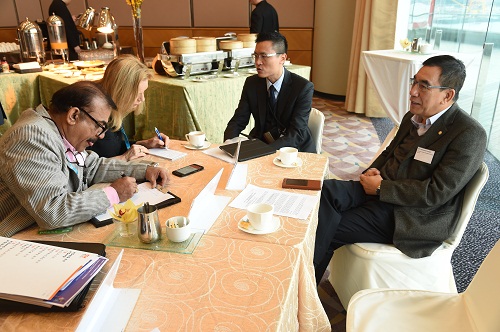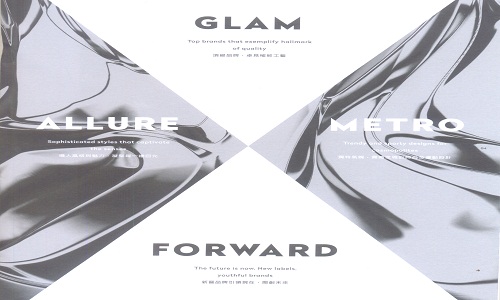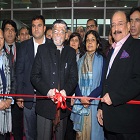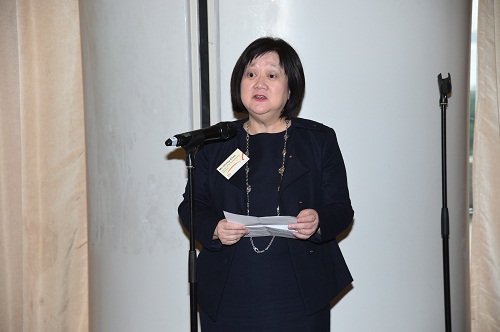FW
CENTRESTAGE being positioned as Asia's Fashion Spotlight will be held from September 7 to 10 this year. An exciting new event is projected to promote Asian designers and fashion brands to buyers. The show will be a combination of exhibition, runways and trend seminars."

HKTDC is all set to introduce a new show named CENTRESTAGE this September to showcase regional and global fashion. The four-day show being positioned as Asia's Fashion Spotlight will be held at the HK Exhibition and Convention Centre from September 7 to 10 this year. The inaugural show, an exciting new event is projected to promote international and local designers and fashion brands to buyers in Asia with a star-studded line-up of regional and international brands and designers.
CENTRESTAGE is projected to be a dedicated marketing platform for international and regional brands, ready to wear and designer labels, with a focus on Asia. Exhibitors can reach regional media, invited fashionistas and fashion buyers, especially from multi-brand stores, select shops, department stores, and fashion e-tailers. An impressive array of events will be held during the fair, making it a premier launch pad to showcase latest collections to the fashion industry.
Show promises never a dull moment “The show will be a combination of exhibition, runways and trend seminars. The first event aims to have a compact size with around 200 participants. Two formats of fashion shows ‘medium’ and ‘large’ are being planned. Medium shows will have an audience base of 400 while large shows would see 800 to 1,000 audiences. We are targeting emerging brands, labels, established and young designers to participate in the event,” explained Byron Lee, Senior Exhibitions Manager, HKTDC talking exclusively to FashionatingWorld.

The show will have four formats for participants. ‘Glam’ for top brands that exemplify hallmark of quality; ‘Allure’ for sophisticated styles that captivate the senses; ‘Metro’ for trendy and sporty designs for daily and casual wear; ‘Forward’ for edgy fashion created by young designers and new labels. The show is a revamped version of World Boutique, Hong Kong, an event that was being held every year coinciding with January show of Fashion Week for the last 13 years. It is being repositioned and rechristened as CENTRESTAGE. “The idea is to align with the latest international fashion calendar, finding the right ‘gap’ in buyers’ calendar,” opines Byron. Explaining further he adds, “The Asia specific event will have an exploding start with new trends featured through runway shows. The show shall have citywide promotions.”
Spotlight is on Asia Established and young designers from HK, Japan, China, Taiwan, Thailand, Indonesia, Korea including India would be participating and offering their products and creations for buyers seeking Asia specific offerings. “We shall welcome buyers from the US, and from the western world but with Asia focused offerings. Asian buyers and Asian products though is the main focus. Emerging country like India would also be a target for designers and brands to showcase. We would be looking for importers, MBOs, select shops, department stores and fashion etailers et al as buyers,” informs Byron, adding that they would be equally targeting brands and designers for participation. However, the number of participant designers would be more from HK.
On whether this would be an ‘Asia to Asia’ focused show, he says, “Yes and no. Of course, the focus is more for Asian offerings. Western buyers’ calendar is generally very tight during September/October and buyers at CENTRESTAGE wouldn’t be looking for western products.”
CENTRESTAGE will further strengthen Hong Kong’s position as Asia’s fashion hub and the annual Hong Kong Young Fashion Designers’ Contest (YDC), which has discovered many talented local designers over the years, will also be held during CENTRESTAGE this year. YDC 2016, will be held under new rules, with four prizes to be awarded: Champion, first runner-up, second runner-up, and Best Footwear & Accessories Design Award (sponsored by i.t). “We are thinking of re-introducing ‘Fashion Extravaganza’ that was part of our earlier World Boutique Fashion Weeks in CENTRESTAGE, where celebrities would be invited in all the shows. The fourth and last day of CENTRESTAGE shall also be open to consumers.”
Rumors about China’s allocation of cotton quotas keep rolling out now-a-days. One rumored version is that among total quantity of 894kt of quotas, 300kt to state-owned enterprises under 1 per cent tariff, 160kt to other eligible textile mills under 1 per cent tariff and 434kt of processing trade quotas.
In another version, 250kt to state-owned enterprises, 150kt to other eligible textile mills and 494kt of processing trade quotas. Moreover, it was heard that some mills have received the notice to apply for the quotas, but according to our sources, most mills did not get this notice. If the quotas do not allocate before the Chinese Lunar New Year, it may be allocated till end Feb, 2016.
As far as importers are concerned, it is a bearish news for them as it is more difficult to get ordinary trade quotas. For quota prices, it is supposed to decrease evidently. In general, the price of cotton quotas depends on the price gap between Chinese cotton and international cotton. Nevertheless, prices are affected by the supply and demand sometimes.
The 2016 cotton planting season is just around the corner and growers are busy studying variety information to make the best seed selections for their farm operations. Last year in the US, Dow Agro Sciences’ Phytogen cotton seed brand was the top planted Pima- and Upland Acala-type cottons in the Golden State, followed by Bayer Crop Science’s FiberMax and Stoneville cotton. Nearly half of the California Upland crop was spread across four Phytogen varieties. More than 82 per cent of the Pima crop was planted in two Phytogen varieties, according to the U.S. Department of Agriculture.
New to PhytoGen’s 2016 Acala cotton seed line-up is PHY 764 WRF with glyphosate resistance and WideStrike. Peck says two Tulare County growers last year yielded 20 per cent more lint with PHY 764 WRF, compared to PHY 725 WRF. PhytoGen’s Pima cotton offerings for California include: PHY 802 RF, PHY 805 RF, PHY 811 RF, PHY 830, plus two new varieties for 2016 - PHY 841 RF and PHY 881 RF. The new varieties have larger seeds compared to most Pima varieties.
Meanwhile, about 45 per cent of Arizona’s cotton acreage last year was planted in Monsanto Deltapine varieties. The company’s DP 1055 B2RF variety was the most popular variety, planted on 23 per cent of the state’s acreage. Dave Albers, Monsanto’s cotton germplasm manager, calls the company’s DP 1044 B2RF, DP 1219 B2RF, and DP 1359 B2RF the “Big Three” varieties in Arizona.
After making inroads in much of Asia, Italian clothing brand Diesel has set its sights on Malaysia. Diesel feels it will sell well in Malaysia, because Diesel-branded fragrances—offered by licensee L’Oréal —are already in demand there. Diesel jeans typically sell for 130 dollars and up, and T-shirts are generally priced between 45 and 150 dollars.
Global brands in search of growth are increasingly relying on Asian economies with a rapidly swelling middle classes. Even as demand for everything from apparel to electronics flattens or shrinks in the West, Asian consumers are still clamoring for such goods. Global brands want to foray in these countries because it’s becoming more important to their bottom line.
However, in countries like Indonesia, a fascination with global brands is colliding with a desire to preserve traditional values. That means global brands have to re-visit the relationships they want to build with people. Only four of the top brands originate in Asia. China does not have a single brand on the global rankings yet. But given the size and volume of Asian business today, it is evident that Asia can build many more prominent global brands and capture more financial value from better price premiums and customer loyalty.
"The 56th India International Garment Fair, (IIGF) 2016 was inaugurated by the minister of state for textiles, Santosh Kumar Gangwar at Pragati Maidan, New Delhi. In his address, the minister highlighted the need to strengthen the apparel exports. Given its employment and export capacity, the apparel industry plays a significant role in the country’s economy."

The 56th India International Garment Fair, (IIGF) 2016 was inaugurated by the minister of state for textiles, Santosh Kumar Gangwar at Pragati Maidan, New Delhi. In his address, the minister highlighted the need to strengthen the apparel exports. Given its employment and export capacity, the apparel industry plays a significant role in the country’s economy. Several new initiatives have been undertaken by the government under the leadership of Prime Minister Narendra Modi to make development participative and inclusive, in line with the core governance philosophy of ‘Sabka Saath, Sabka Vikaas’.
Need to focus on apparel exports

Rashmi Verma, Secretary Textiles, emphasized on the economic vision based on boosting manufacturing, growing exports and generating more and more employment. The idea is to embark on a path of inclusive and participatory growth. She explained that the objective is to showcase latest garment and fashion accessories trends shaping up. This sector being the highest employment provider in the manufacturing sector has a much bigger role and responsibility. India has the significant advantage of a young population offering huge potential for a demographic dividend by getting gainful employment in this sector with just three months of training, she added.
Ashok G Rajani, Chairman Apparel Export Promotion Council (AEPC) observed, that the garment export industry can generate 2,200 jobs with an investment of Rs 30 crores in land, building machinery and utilities. The unique feature of the industry is that with the Rs 30 crores investments, garment exports worth Rs 120 crores can be achieved, out of which, Rs 30 crores would go as wages to the workers. The textile industry accounts for 14 per cent of industrial production, which is around 4 per cent of India’s GDP. Out of 45 million people in the textile industry, 11.22 million people are in garment sector alone. Nearly 60 to 70 per cent workforce is of women, mostly from the weaker sections of the society. The garment export sector is currently worth $17,000 million, having a world market share of around 3.5 per cent only, he added.
Rajani said the 56th IIGF has attracted 809 buyers from across the globe, of which 259 have availed MAI benefits; there are 350 buying agents and 200 visiting buyers for the 56thIIGF. There are 322 participants for the 56th IIGF and number of buyers registered on the IIGF website is 1720. This data shows that the buyers across the world have stated showing faith and sees India to be a safe and compliant destination for sourcing garments, he said.
Expressing the concerns of garment export industry, he said they are concerned about Vietnam’s zero duty access to EU market. Vietnam exports are likely to grow faster due to implementation of zero duty from 2017. (India faces import duty of 9.6 per cent). Trans Pacific Partnership Agreement allows export opportunities in Vietnam to US with a benefit of 17-30 per cent export duty relief. India-EU Broad-based Trade and Investment Agreement (BTIA) are yet to be finalized, exporters are expecting faster conclusion of the talk so that they can compete with Bangladesh and Vietnam.
Talking about garment exports growth Rajani said, RMG exports were to the tune of $1,440.8 million in December 2015 with an increase of 5 per cent against the corresponding month of December 2014 which was $1,372 million. India’s RMG export to World in April-December of 2015-16 was to the tune of $1,2473.9 million which is up by 2.8 per cent compared to the same period of previous financial year. During April-December 2014-15, India’s apparel exports were to the tune of $1,2137.1 million. Rajani also requested the government to simplify the labour laws, which is the need of the hour.
Organised by AEPC, IIGF is India’s largest garment show in South Asia, covering Apparel and Fashion Accessories; encompassing a vast exhibition area of around 15824 square meters.
A State Bank of Pakistan (SBP) study says, Pakistan textile exporters are losing their share in the US market as compared to competitors. In its first quarterly review released recently, the central bank said that in the US market overall import demand for textiles and apparel increased during July-September 2015, however, Pakistan had not been able to firm up its exports.
The study observed that the market for manmade fiber products is expanding at a fast pace, but Pakistan has failed to diversify its product range accordingly as a result, Pakistan has now begun to lose its share even in the cotton apparel market of the US. The SBP said that textile exports continued to face subdued global demand. The cloth manufacturing progressed slowly due to depressed demand from the European market.
The report added, in the yarn segment, availability for cheaper yarn from India posed serious challenges to local manufacturers. “However, the situation is expected to improve, as the government has imposed 10 per cent duty on yarn imports from November 1, 2015.” Pakistan’s textile exports registered a decline of 5.6 per cent during the first quarter of 2015-16 mainly due to shrinking global demand. The overall imports of textile and clothing of the European Union declined sharply during the period under review.
However, in the clothing segment, all major countries faced a decline in exports to the EU, except Pakistan and Bangladesh. These two countries enjoy duty-free access to this market: Pakistan in terms of GSP+ and Bangladesh via Everything-But-Arms (EBA), the SBP report said.
The devaluation of the yuan has caused jitters among garment exporters in India. Garment exports from China will get an impetus as more and more buyers will source products from there since they could become cheaper. Already, China is the leading exporter of textiles and clothing in the world.
In contrast garment exporters in India like the knitwear cluster face rising production costs and shrinking profit margins. Tirupur knitwear cluster imports large chunks of machinery, raw materials like knitwear printing inks and accessories that provide embellishments to the garments.
Rupee volatility has been a problem for the last few months. If the rupee continues to slide, it can upset the costing of end products as garment orders usually take a few months to execute. Since currency markets cannot be controlled, Indian exporters want incentives that will arrest any further widening of the trade deficit and help them remain competitive. They feel rates of duty drawback and interest subvention can be increased and more sops be given to increase exports to focus markets so as to enable exporters to increase their market share. China further devalued the yuan against the dollar a few days back, setting the daily reference rate to the lowest since 2011.
Korea’s Dongyang MirAcle successfully developed ‘Ultra High Molecular Weight Polyethylene (UHMWPE) yarn,’ one of the strongest among synthetic fibers which have led Korea's technical textile industry. It established the research center in 2007 to develop high tenacity fiber, new material fiber and automation facilities. An official of the Dongyang MirAcle explained that MirAcle which has been produced through gel spinning has specific strength 15 times higher than steel wire, and it has excellent UV resistance and chemical resistance. He added that since it has an excellent abrasion resistance and can be used in extremely harsh conditions, the scope of application will be widened.
Dongyang claims to be the only company in the world which can supply HDPE yarns in all range of tensile strength since it has developed not only gel spun UHMWPE yarn, MirAcle but also melt spun HDPE yarn.
Owing to the limitation of domestic technology, the UHMWPE yarn and melt spun HDPE yarn were all imported. Since the import volume was limited, the development of new applications using high tenacity HDPE yarns has been too slow. However, the MirAcle which has excellent quality compared to other companies was specialized in order to develop customized products by supplying excellent tenacity, creep characteristics, coating performance and customized specification.
The developed product can be applied to military supplies such as bulletproof jacket and bulletproof helmet, leisure and sports goods, and used for high performance rope, high performance fishing net, industrial safety gloves, protection gears, mountain bike frame, rock climbing rope, paragliding, fiber reinforced concrete, high performance motorcycle helmet, baseball stadium net, dental floss, gastro scope wire, industrial fabric, non-woven fabric, staple fiber and suture, etc.
Asia Apparel Expo will be held in Germany from February 24 to 26, 2016. About 250 companies are participating in the expo. Among the participating countries are: Hong Kong, China, Bangladesh, Pakistan, Myanmar, Thailand, India, Cyprus, Belgium and Poland.
The expo is designed to meet the demand from European customers for finished garments, contract manufacturing and private label development. The apparel products on show cover men’s, women’s and children’s wear, sportswear and work wear, fabrics and textiles, as well as trimmings and accessories from the carefully-selected factories.
For the fourth edition in February 2015, over 1,500 trade professionals attended, many of whom repeated their visits over the three days, reinforcing that the well-edited selection and variety of factories and suppliers is a convenient sourcing center for apparel buyers.
Asia Apparel Expo will continue to expand its role in providing European buyers with the opportunity to meet with potential new suppliers and learn of the most up to date sourcing and production information from Asia.
The event will feature a sustainable fashion design competition. The goal of the competition is to inspire emerging fashion designers and students from Asia and Europe to create high fashion pieces with minimal waste, utilizing zero-waste, up-cycling and reconstruction design techniques.
www.asiaapparelexpo.com/
Première Vision Paris will open its doors from February 16 to 18, 2016 in a complex and still unstable economic and political context. Facing continually weakened global apparel consumption, both in traditional as well as new markets, Premiere Vision Paris continues to demonstrate its strength, and the strength of its concept. With 1,720 exhibitions and six complementary activities, Première Vision Paris plays strength and a transversal approach to the global creative fashion industry.
The 1,720 exhibitors include: spinners, weavers, accessory makers, design studios, tanners and garment manufacturers. They are presenting their latest creative developments to the many buyers, stylists and fashion and accessory brand designers who come each season to Première Vision Paris to find inspiration and unearth innovative collections that will make a difference to their collections.
Following a record show in 2015, this time the number of global exhibitors is 4 per cent lower, down from 1,793 exhibitors in February 2015. This figure remains nonetheless quite high and is exceptional for the industry as a whole. Among the offers proposed at the various international shows targeting the upstream sector, the Première Vision Paris event is unquestionably the most complete, the most international and the highest in quality.













